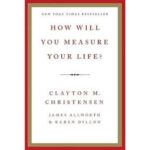LISTEN NOW
Outline: How Will You Measure Your Life? by Clayton Christensen
Outline
Expand to Read ...
Introduction: Applying Economic Theories to Life
- Premise: Economic theories that guide business success can also be applied to personal and professional fulfillment.
- Goal: Help readers identify what matters most, avoid common pitfalls, and find happiness and success in their careers and personal lives.
- Approach: Christensen uses proven theories to offer frameworks for sound decision-making, rather than anecdotal advice.
Core Concepts
- The Importance of Theories
- Theories predict cause-and-effect relationships, providing direction for decision-making.
- Good theories serve as navigational tools for life’s challenges, helping individuals make intentional choices.
- Responsibility for Implementation
- Theories provide a framework, but individuals must apply them to their unique circumstances.
Finding Happiness in Your Career
- Understanding What Motivates You
- Theory: Motivation arises from intrinsic factors like meaningful work, responsibility, growth opportunities, and making an impact.
- Application:
- Assess if a job aligns with motivators, not just hygiene factors (salary, job security, status).
- Ask: Is this work meaningful? Does it offer growth and achievement?
- Balancing Plans With Opportunities
- Theory: Strategies evolve through anticipated opportunities (deliberate strategy) and unanticipated challenges or possibilities (emergent strategy).
- Application:
- Evaluate job opportunities by questioning assumptions: Will I enjoy this role? What support is needed for success?
- Validate assumptions through research and observation.
- Aligning Resources With Priorities
- Theory: Resource allocation reflects true priorities. Daily decisions reveal whether actions align with goals.
- Application:
- Allocate personal resources (time, energy, talent) toward long-term aspirations, not just immediate rewards.
- Balance career goals with commitments to relationships and personal well-being.
Finding Happiness in Your Relationships
- Determine the Job to Be Done
- Theory: Products succeed when they fulfill specific customer needs (“jobs to be done”). Relationships thrive when you identify and meet the needs of others.
- Application:
- Understand what your spouse, children, or friends need from you.
- Avoid projecting your assumptions onto others; prioritize empathy and communication.
- Develop Your Children’s Capabilities
- Theory: Core capabilities arise from resources, processes, and priorities. Outsourcing critical functions can undermine future success.
- Application:
- Focus on teaching children problem-solving skills, values, and decision-making processes.
- Dedicate time to instilling core values rather than delegating these responsibilities.
- Create a Family Culture
- Theory: Culture is a shared set of norms and practices that guide decisions in the absence of supervision.
- Application:
- Establish a family culture based on priorities and values, such as kindness or resilience.
- Model desired behaviors and reinforce them through repetition and problem-solving.
Living With Integrity
- Avoid Marginal Thinking
- Theory: Marginal cost thinking prioritizes short-term gains over long-term consequences, leading to significant failures.
- Application:
- Uphold ethical principles consistently—compromising “just this once” can erode integrity.
- Assess the long-term impact of decisions to avoid cumulative negative outcomes.
- Learn From Case Studies
- Example: Nick Leeson concealed a small mistake, leading to escalating risks and the collapse of Barings Bank.
- Lesson: Minor lapses can spiral into significant failures if not addressed with integrity.
Choose Your Purpose
- Purpose in Business
- A company’s purpose provides:
- A vision of its goals.
- Commitment from employees.
- Metrics to measure progress.
- A company’s purpose provides:
- Purpose in Life
- Define the type of person you aspire to be and your life goals.
- Commit to your vision and establish metrics to track progress.
- Guiding Framework
- Use your purpose as a North Star to navigate decisions in career, relationships, and ethical challenges.
Conclusion
- Key Takeaway: The principles and theories from business can guide meaningful, intentional living.
- Final Question: How will you measure your life? Use the frameworks presented to ensure your actions align with your long-term vision for happiness and success.

 Buy on Amazon
Buy on Amazon